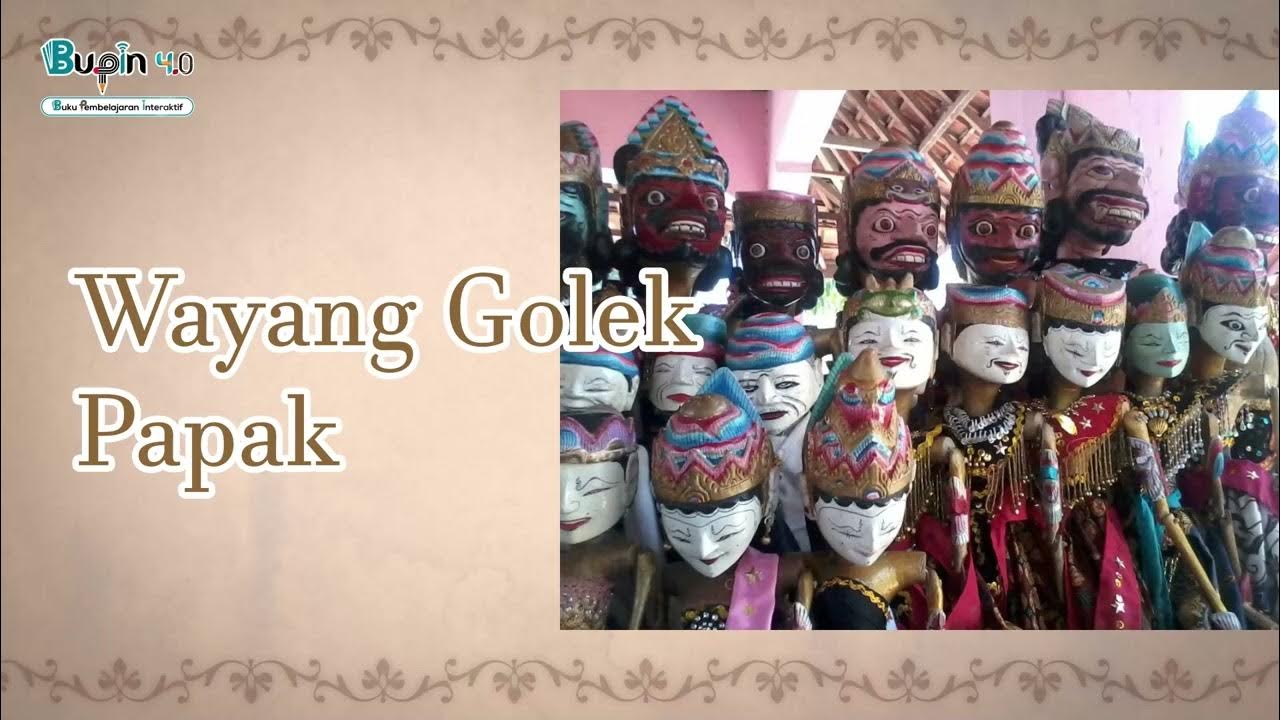MATERI WAYANG - JENIS-JENIS WAYANG | WAYANG KULIT | WAYANG GOLEK | WAYANG WONG - (BAHASA JAWA)
Summary
TLDRThis video script explores the rich cultural and educational significance of Wayang, a traditional form of Javanese puppet theater. It delves into the history, functions, and types of Wayang, such as Wayang Kulit (leather puppets), Wayang Golek (wooden puppets), and Wayang Wong (human actors dressed as puppets). The script also emphasizes the moral lessons, societal values, and cultural preservation embedded in these performances, drawing on stories from epic texts like the Mahabharata and Ramayana. Additionally, it touches on various regional styles and highlights the importance of preserving local traditions against external influences.
Takeaways
- 😀 Wayang, derived from the word 'wod,' represents the soul and spirit, offering teachings on proper conduct (Toto Kromo) and ethics (Susila).
- 😀 Wayang serves as a medium for education, entertainment, and cultural preservation, while also promoting the introduction of religion.
- 😀 The term 'wayang' also refers to shadows, as traditional performances use screens or cloths to create shadow effects, symbolizing human nature.
- 😀 Wayang performances depict human behavior and social life, offering moral guidance and examples for proper living.
- 😀 The three main functions of wayang are: entertainment, education, and cultural heritage preservation.
- 😀 Wayang is a local theater that should be appreciated and maintained within its own culture to prevent foreign appropriation.
- 😀 Different types of wayang include: wayang kulit (shadow puppets), wayang golek (rod puppets), wayang suket (grass puppets), wayang potehi (cloth puppets), and wayang kronik (chronicle puppets).
- 😀 Wayang kulit, made from animal hides, often tells stories from the Mahabharata or Ramayana, and is divided into various regional styles such as Yogyakarta and Banyumas.
- 😀 Wayang golek uses wooden puppets and is popular in the Sunda region. There are two main types: wayang golek papak and wayang golek purwo.
- 😀 Wayang suket, made from grass, is similar to wayang kulit but uses natural materials to create the puppets. It has been used in various performances, including those by Pak Slamet Gundono.
- 😀 Wayang wong involves human actors who dress and perform as if they are puppets, with stories drawn from the Mahabharata and Ramayana. It features elaborate dances and performances, including roles of comedic characters like Punokawan.
Q & A
What is the origin of the word 'wayang'?
-The word 'wayang' comes from the Javanese word 'wod,' which means 'spirit' or 'soul.' It refers to the shadow play of figures that represent human characteristics and souls.
What is the primary function of wayang in Javanese culture?
-Wayang serves multiple purposes, including being a medium for education, entertainment, promoting religious teachings, and preserving cultural traditions.
How does wayang depict human character and soul?
-Wayang represents human character and soul by using figures that embody human traits, often portraying both moral teachings and the complexities of life.
What are the different aspects that wayang conveys about life?
-Wayang conveys aspects such as proper behavior (Toto kromo), good manners (Susilo), social conduct, and moral guidance in various aspects of life, including social relationships and ethics.
What are the various types of wayang mentioned in the script?
-The script mentions several types of wayang, including wayang kulit (shadow puppetry), wayang golek (wooden puppets), wayang suket (grass puppets), wayang potehi (cloth puppets), and wayang kronik (chronicle puppetry).
What is the significance of wayang kulit?
-Wayang kulit is a form of shadow puppetry made from cow or buffalo skin, typically performing stories from the Mahabharata or Ramayana, and it is a key part of traditional Javanese culture.
What is the difference between wayang golek papak and wayang golek Purwo?
-Wayang golek papak and wayang golek Purwo are two variations of wooden puppet theater in the Sundanese region, with each having distinct styles of puppetry.
How is wayang suket different from wayang kulit?
-Wayang suket is made from grass or plants, whereas wayang kulit is made from animal skins. Wayang suket represents an innovative variation of the traditional form of wayang.
What is wayang wong, and how is it performed?
-Wayang wong is a form of theatrical performance where human actors impersonate the characters of wayang. Actors dress up to resemble wayang figures, and the performances often include dance and traditional music.
What is the cultural significance of wayang potehi?
-Wayang potehi, originating from Chinese culture, is a type of glove puppetry that has been integrated into Indonesian culture. It features elaborate costumes and tells stories based on Chinese legends, representing cultural fusion.
Outlines

This section is available to paid users only. Please upgrade to access this part.
Upgrade NowMindmap

This section is available to paid users only. Please upgrade to access this part.
Upgrade NowKeywords

This section is available to paid users only. Please upgrade to access this part.
Upgrade NowHighlights

This section is available to paid users only. Please upgrade to access this part.
Upgrade NowTranscripts

This section is available to paid users only. Please upgrade to access this part.
Upgrade Now5.0 / 5 (0 votes)





